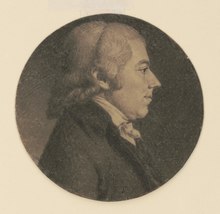Matthew Clay
Matthew Clay | |
|---|---|
 Matthew Clay (portrait) | |
| Member of the U.S. House of Representatives from Virginia's 15th district | |
| In office March 4, 1815 – May 27, 1815 | |
| Preceded by | John Kerr |
| Succeeded by | John Kerr |
| Member of the U.S. House of Representatives from Virginia's 14th district | |
| In office March 4, 1803 – March 3, 1813 | |
| Preceded by | Samuel Jordan Cabell |
| Succeeded by | William A. Burwell |
| Member of the U.S. House of Representatives from Virginia's 6th district | |
| In office March 4, 1797 – March 3, 1803 | |
| Preceded by | Isaac Coles |
| Succeeded by | Abram Trigg |
| Member of the Virginia House of Delegates from Pittsylvania County | |
| In office 1790–1794 Alongside Benjamin Lankford, Thomas Tunstall and Stephan Coleman | |
| Personal details | |
| Born | March 25, 1754 Halifax County, Virginia Colony, British America |
| Died | May 27, 1815 (aged 61) Halifax, Virginia, U.S. |
| Resting place | Pittsylvania County, Virginia |
| Political party | Democratic-Republican |
| Military service | |
| Branch/service | Continental Army |
| Years of service | 1776–1783 |
| Rank | quartermaster |
| Unit | Ninth, First and Fifth Virginia Regiments |
| Battles/wars | American Revolutionary War |
Matthew Clay (March 25, 1754 – May 27, 1815) was a United States Representative from Virginia.
Biography[]
Son of Rev. Charles Clay, Matthew Clay was born in Halifax County in the Colony of Virginia. During the American Revolutionary War he entered the Ninth Virginia Regiment on October 1, 1776. He transferred to the First Virginia Regiment in 1778 and to the Fifth Virginia Regiment in 1781, being successively promoted to first lieutenant, captain, and quartermaster. He was mustered out 1783.
Clay was a member of the Virginia House of Delegates from 1790 to 1794 and was elected as a Democratic-Republican to the Fifth and to the seven succeeding Congresses, serving from March 4, 1797, to March 3, 1813. While in the House he was chairman of the Committee on Militia (Tenth Congress). He was an unsuccessful candidate for reelection in 1813 to the Thirteenth Congress. His refusal to vote in favor of the Declaration of War against Great Britain in June 1812 (Clay abstained on the vote, one of only two Virginia Republicans who declined to vote for the Declaration) was unpopular with his constituents and contributed to his defeat.[1] Clay won back his seat in the next election. He served in the Fourteenth Congress from March 4, 1815, until his death at Halifax Court House in 1815. Interment was in the old family burying ground in Pittsylvania County.
Matthew was one of the original trustees (in 1793) of the then unincorporated town of Danville. The others were Thomas Tunstall, William Harrison, John Wilson, Thomas Fearne, George Adams, and Thomas Smith
Matthew Clay was a brother of early Kentucky politician Green Clay and first cousin of the statesman Henry Clay. Matthew's daughter Mary was a victim of the Richmond Theatre fire of 1811.
Elections[]
- 1797; Clay was elected to the U.S. House of Representatives unopposed.
- 1799; Clay was re-elected defeating Federalist Isaac Coles.
- 1801; Clay was re-elected unopposed.
See also[]
References[]
- United States Congress. "Matthew Clay (id: C000487)". Biographical Directory of the United States Congress.
- 1754 births
- 1815 deaths
- People from Halifax County, Virginia
- Continental Army officers from Virginia
- Green Clay family
- Quartermasters
- Members of the Virginia House of Delegates
- Members of the United States House of Representatives from Virginia
- Virginia Democratic-Republicans
- Democratic-Republican Party members of the United States House of Representatives
- 18th-century American politicians
- 19th-century American politicians
